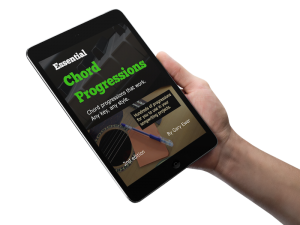Songwriters can be forgiven for looking for new and exciting chord progressions. There’s a fear that if you use a progression that’s been used before, it will sound either boring or overused, and lacking in originality.
The truth is that as long as the chords are properly supporting the notes of the melody, even mundane I-IV-V-type progressions — the ones that are probably used in many thousands of songs — won’t be a detriment to an otherwise good song.
 If, as a songwriter, all you really need is a list of chords to try out, “The Essential Secrets of Songwriting 10-eBook Bundle” has two collections of progressions, plus an eBook dedicated to showing you how to add chords to a melody.
If, as a songwriter, all you really need is a list of chords to try out, “The Essential Secrets of Songwriting 10-eBook Bundle” has two collections of progressions, plus an eBook dedicated to showing you how to add chords to a melody.
That’s why I like using the landscape analogy when describing how good chords work. A nice piece of land, with some gently rolling hills, is the perfect setting for a country house. As long as that land properly supports the house, both from an engineering and aesthetic standpoint, that’s going to be good land, no matter how much it looks like someone else’s land.
But let’s say that, even though you might agree with that, you still want to have a chord progression that has something more unique about it, something that doesn’t show up in quite so many songs.
In those cases, it can be better to take an existing, “boring” progression and modify that one, rather than trying to invent something entirely new. There’s a simple reason for that: it’s highly unlikely you’d be able to invent anything entirely new; practically every possible progression that works has been used before.
Bass Pedal Point
Adding pedal point to a progression is a great way to make it sound interesting, while keeping the basic structure of the progression intact.
A bass pedal point means keeping the same note in the lowest-sounding instrument while the chords above change. The bass pedal point works even though the bass note at any given moment may not (and likely won’t) be a note from the chord being played.
For example, here’s a progression you might find rather overused or uninteresting:
C - Dm - G7 - C
Now, keep the C in the bass while the chords change above it, and you get this:
C - Dm - G7 - C ___________ C
There’s a nice “freshness” to a progression that uses a bass pedal point in this way. The progression retains the tonally strong structure, but the fact that the bass note doesn’t exist normally in Dm or G7 adds a great sense of musical flavour.
Because this progression is in C major, and the bass note being held is a C, we call it a tonic bass pedal point. You can choose to hold on to any bass note from that progression, but the most common choices are the tonic note (C) or the dominant (i.e., 5th) note (G).
Here’s what that progression would sound like with a dominant pedal:
C - Dm - G7 - C ___________ G
Any time you feel that you need something different in your chord progression, I always recommend starting with something tonally strong and basic, and use that progression as the basis for something new. Anything you do to that progression means it will likely keep the strength of the original progression, and that’s almost always going to be the best way forward for most songs in the pop genres.
 Written by Gary Ewer. Follow Gary on Twitter.
Written by Gary Ewer. Follow Gary on Twitter.
 If you like the chords-first songwriting method, you need to be sure you aren’t compromising the quality of your melodies. “Writing a Song From a Chord Progression” shows you the best way to create compelling songs by starting with the chords. This eBook is part of “The Essential Secrets of Songwriting 10-eBook Bundle”
If you like the chords-first songwriting method, you need to be sure you aren’t compromising the quality of your melodies. “Writing a Song From a Chord Progression” shows you the best way to create compelling songs by starting with the chords. This eBook is part of “The Essential Secrets of Songwriting 10-eBook Bundle”











Pingback: The 5 Most Important Things To Know About How to Use Chord Progressions In Your Songs | The Essential Secrets of Songwriting